 |
||
|
||
| ||
There is some stagnation on the barebone market segment, which is apparently caused by rather high average prices for such systems along with their innate expandability limitations. Despite that, all those willing to build a compact computer with attractive (or at least unusual) appearance can find something suitable. In this article we shall have a look at a barebone of the standard (if the term is at all applicable) format. A "cubic" computer chassis with a motherboard that has integrated graphical core, but not without additional capability to install a fully-functional video card. Appearance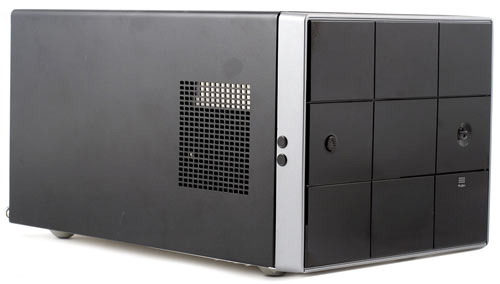
Chassis is designed using predominantly black color. Only the front panel side-frame is silver-like. The polished front panel can be considered a plus or a minus, because the pretty shine is very much dependent on one's determination to keep the surface clean from dust and finger prints. Nevertheless, these kinds of coatings became popular not only among monitors, speakers and other peripherals, but also with much more exposed to the elements notebook computers. Hence, this decorative style must have many supporters. Chassis size is traditional for SFF - 210x330x175 mm. Front panel bays (optical drive, card-reader) and peripheral ports are covered with lids. Cover for the 5-inch bay has a spring and opens when the CD/DVD tray is ejected. Controls in keeping with tradition include a power-on button and original "remote" button for opening the disk tray. The control signal must be sent over the IDE bus, whereas most chassis with decorative bay covers use a mechanism that presses the corresponding button of the optical drive itself.
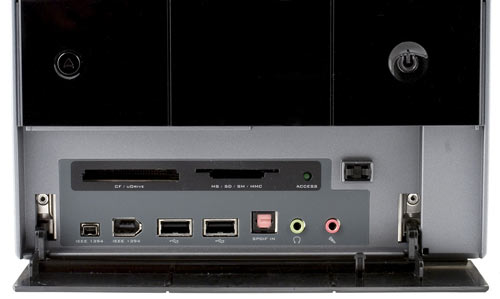
The front panel houses two USB 2.0 ports, two FireWire 400 (4- and 6-pin), optical S/PDIF-In and interfaces for headphones and a microphone. It is peculiar that FireWire ports are located on the front panel only. Perhaps MSI considers all peripherals connected via this interface exclusively mobile.

The rear panel has an abundance of graphics connectors. This includes VGA, DVI, composite as well as S-Video Out. PS/2 mouse and keyboard ports, which are becoming rare in compact systems, are located here as well. Here we also find 3 USB (2.0) ports, a network socket (Gigabit Ethernet), 6 analog audio-sockets for outputting 7.1-channel sound and S/PDIF-Out. At the top of the rear panel there is a detachable antenna for a Wi-Fi module. This module is included by default instead of being an option, which is also rare. Internal design and functionality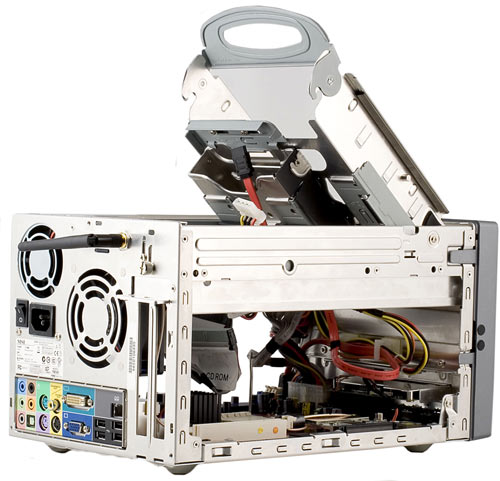
Likely the most interesting feature in the chassis design is the opening and easily detachable hard drive and optical drive bays. Thanks to this solution it is possible to access the system board and install all components except the CPU cooler without having to use any tools.
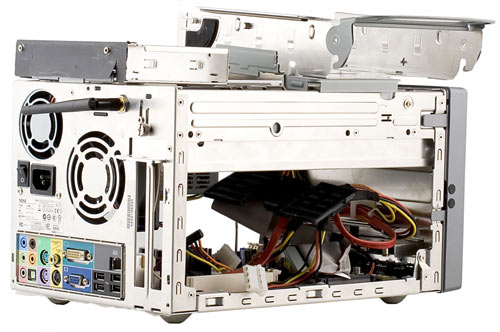
Hard drive and optical drive are mounted in respective bays without any screws, while the rack can be easily taken apart for convenient installation.

Since the design only allows one hard drive and one optical drive to be installed, the chassis appears spacious enough on the inside despite its compact size. This attribute should promote free air circulation. Data and power supply cables run along the front side and are carefully fixed. It isn't quite apparent on the picture due to obstruction by cables disconnected from the disk bay, however a complete assembly leaves no cables hanging loose inside. Such implementation also contributes to effective circulation of air.

The system board has brand identification as MS-7214 and is, naturally, specifically designed for this chassis. To its advantage it uses a fully functional GeForce 6150 chipset with nForce 430 southbridge instead of cut-down variations with reduced core frequency or functionality that are becoming so popular lately. Nevertheless, chipset functionality is not completely implemented on this board (there isn't really a need for that) and includes the following:
The system board also has CD-In and AUX-In sockets, as well as a CPU fan connector. Unfortunately, the list of components tested for compatibility that is provided on the manufacturer's web-site doesn't include video cards, neither does the instructions document. Yet the issue of support isn't insignificant, because the graphics port itself is well-placed and could house a full-sized video card with double-slot cooling system. That is exactly what we have tried with our standard testbed ATI Radeon X1900XTX. The board has no extra 6-pin power supply connector for such a video card, so we had to use an adapter. Alas, as a result the video card cooler was spinning at a maximum rate (which always happens at start-up but doesn't last long), but the picture was missing. The testbed computer booted up and operated normally using integrated graphics instead, while the video card cooler kept on spinning. Even the hardest tests caused no malfunctions, so it would be incorrect to put the blame on insufficient output from power supply unit. Most likely the system is simply incompatible with this specific video card model. Having repeated the test with a graphics adapter based on Radeon X800 XL that happened to be around we have noticed no abnormalities. In particular, we have discovered that adding such a card doesn't turn the system into a noisy oven. On the contrary, the heating of the other components has increased insignificantly, which we discuss below in more detail. We have evaluated quality of the integrated audio in 16-bit 44-KHz mode using RightMark Audio Analyzer 5.4 testing suite and ESI Juli@ sound card:
Overall rating: Good. This result is closer to the characteristics of AC'97 standard audio codecs. This can be really confusing, especially considering the fact that the manual itself specifies the integrated codec as AC'97. It is a disappointing mistake, because PCI-slots are scarce in compact systems, and it is necessary to make do with the system's integrated functionality, which in that case should match the average level of modern system boards or ideally even surpass it. The system board's BIOS contains no overclocking settings. Of all the similar options there is only memory voltage selection, which can be used to improve stability in case of incorrect automatic voltage setting by the more expensive models, which have non-standard default voltage. However, using them is unjustified in this case, because they are designed for overclocking.
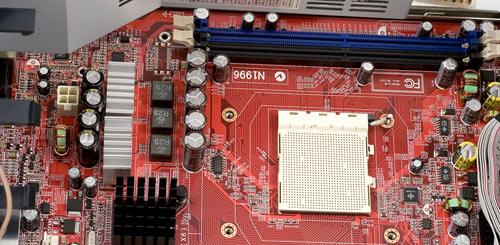
The system board has a 3-channel CPU supply voltage stabilizer with 2 field transistors per channel, which are cooled with heat sinks, 5 capacitors of 3300 microfarad each and 4 capacitors of 1500 microfarad each made by United Chemi-Con. The board's sole jumper responsible for CMOS reset is located very conveniently. Cooling system and temperature conditionsThe cooling system of MSI mPC 51PV consists of a CPU cooler, rear panel fan for drawing hot air out and a power supply unit fan, which additionally cools the other components inside the computer case. All of the fans are capable of adjusting rotation frequency. The CPU and system fan are controlled by the board. BIOS allows only to turn Smart Fan mode on or off, while the temperature thresholds that correspond to various rotation frequencies available in version 1.0 were removed in version 1.1, the current one at the time of testing. Rotation frequency of the PSU fan is set automatically depending on the built-in thermal sensor readings.
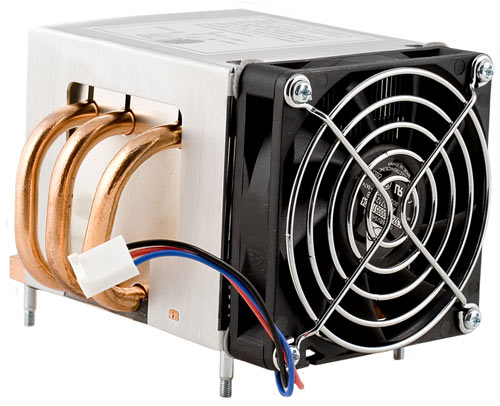
The CPU cooler has been a traditional one for MSI mPC since the release of the series. The cooler is rather effective and quiet at rates of revolution up to 2000 rpm. This is exactly the value it was operating at in our case under "office" load, despite the fact that quite a heating Athlon 64 X2 4000+ CPU of 90 nm series with TDP of 89 W (and Cool'n'Quiet mode off) was used. Of course, the 65 nm version of Athlon 64 X2 Energy Efficient CPU with TDP of 65 W seems to be the most appropriate choice for any compact chassis. However, we are trying to test the system in borderline conditions, assuming that at least it will not behave any worse in the optimal ones.
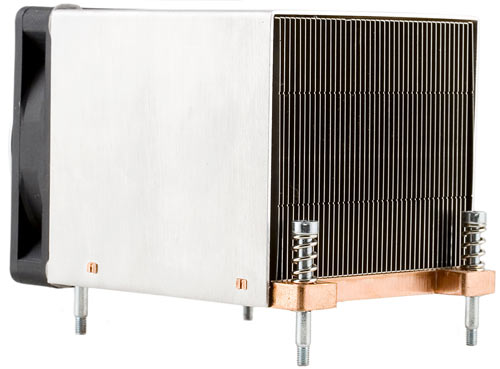 o o
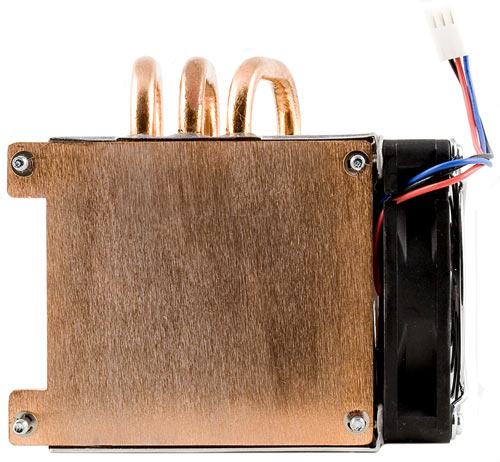

In order to cool the chipset's northbridge a compact heat sink is used. It is too small at first glance, because as we know from experience in testing full-sized boards based on this chipset it heats up quite a lot. However, the placement of both chipset bridges within the air flow from the CPU fan allows getting by with passive cooling and avoid overheating.

The power supply unit also participates in drawing the hot air out away from the memory modules and hard disk bay area. The board's HIPRO HP-U262FF5 PSU outputs 260 W, while the label recommends limiting consumption to 105 W on +5 and +3.3 V lines. We have performed heat emission testing using SpeedFan utility in fully automatic mode (since the system board's BIOS doesn't allow for any other). The system came had AMD Athlon 64 X2 4000+ processor, ATI Radeon X800 XL 256 MB vide card (for tests with discreet graphics), ESI Juli@ sound card, 7200 rpm hard drive and a DVD-drive. The maximum system load was attained while running FarCry (video game) with high resolution. In order to maintain the CPU in maxim load state we used a built-in WinRAR data compression benchmark (with priority of the data compression process set to minimum in Windows "Task manager"). Video playback mode corresponded to repeated playback of a MPEG 2 video clip with 1080i resolution.
The first notable thing is the excellent, if not perfect, cooling of the hard drive and system board. The optimal temperature inside the computer case is maintained regardless of the load. The processor and chipset are also reliably cooled and even in the time consuming tests the temperature of a fully loaded processor has reached the 50 degrees C mark. This value is often chosen as target temperature for the whole work session by home users and with the fan barely spinning is considered acceptable. On the other hand, in modes of high load the computer can't be considered quiet. In the office mode with system cooler rotating at 1600 rpm and CPU cooler - at 1900 rpm the noise level corresponds to a very quiet full-size system and becomes unnoticeable during video playback with the even the slightest accompanying sound. In maximum load mode, though, the cooling system produces considerable noise. We also need to point out that under maximum load the rotation frequency of the fans wasn't constant. As the temperature increased the rotation frequency increased too, and returned to normal as the system cooled off. This creates additional distraction. Most importantly, judging from the results, this increase in rotation frequency was not necessary and a lower frequency would have worked just as well.
Rotation frequency of the system and CPU fans in light load mode didn't change after the discreet video card was installed. The heating of components also increased insignificantly, but even a moderate load caused by video decoding sent both fans spinning at 2000 rpm. This combined with increased noise produced by the video card fan resulted in significant background noise. In maximum load mode the rotation frequency for the system and CPU fans went up to 2700 and 3700 rpm respectively. Even the tolerant users will likely call this mode noisy. Nevertheless, in all of the above cases there still remained a significant margin below the upper bounds of 4000 and 4400 rpm respectively. The same holds true for the heating of components, which enjoy more than comfortable operating conditions in this chassis. In other words, it is very possible to lower the rotation frequency without shortening the service life of the components. Although the BIOS doesn't have a corresponding capability, one can use SpeedFan utility to limit the maximum rotation frequency of the CPU and system fans. In this case the automatic control keeps functioning, i.e. keeps reducing the rotation frequency relative to the maximum value specified. One has to primarily watch the heating of the chipset, because the video card that is located nearby gives away some heat through the graphics port while also raising the air temperature in that area. This explains a strange, at first glance, situation when chipset temperature is higher when a video card is used instead of integrated graphics. The operational temperatures of graphics processors far exceed the temperatures of the rest of the components.

The results obtained for the video card, in contract to chipset graphics, doesn't depend much on the environment. It heated up to similar temperatures in full-sized chassis without any loss of stability. In compensation to the lack of information about supported video cards we managed to find out that the system is guaranteed to be operational with boards based on GeForce 7600GT and Radeon X1650XT processors (and all the rest with lower power consumption). Consequently, of the modern ones Radeon HD 2400 and HD 2600 seem to be perfect candidates. Package contents and brief specifications of the bareboneThe barebone, in comparison to other such systems, is very modest. All it includes is a user's manual, CD with drivers and a detachable radio antenna for the rear panel. The set of brand utilities on the CD is also scarce. It consists of Live Update utility for updating the BIOS and drivers using automatic downloading from the manufacturer's web-site, and PC Alert 4 for monitoring the system parameters. Our particular unit came in a white unmarked box, while retail versions may be shipped in a more decorated one made of glossy cardboard.
Performance analysisTestbed:
Software:
We used the results of the ASUS M2NPV-VM system board based on a similar chipset. The game test results are presented only for the mode using integrated graphics core, because as we have mentioned earlier our standard video card, which we normally use for testing system boards, didn't function on MSI mPC 51PV.
What we have got is indeed a system based on GeForce 6150 chipset with the promised frequency of the graphics core. This fact is pleasing, as well as the minimal loss in tests to the ASUS system board despite the inability to set even the basic memory timings using BIOS. BIOS has accomplished this task automatically. ConclusionIn general, we are pleased with the barebone being examined. The design chosen by MSI engineers is actually very intuitive and should pose no trouble during assembly even for a technically illiterate user. This characteristic is important because the whole idea of such systems is not only about compactness and original appearance, but also about being able to quickly and easily build a computer following illustrated step-by-step instructions. The functionality would have been otherwise good, if it weren't for an outdated audio codec. In terms of noise this MSI model loses to functionally equivalent Shuttle models. The primary reason for that is the less thought-out Smart Fan mode (i.e. the absence of any mode, but fully automatic). On the other hand, this MSI's product deserves a high mark for a not so sophisticated, yet an effective cooling system. Therefore, if you are willing to spend the time and manually set, using SpeedFan utility for example, the rotational frequencies of the fans that suit your configuration, you will get an equally quiet system. Of course, we suggest as usual choosing economical components for the system, which will allow you to keep the noise low under a light as well as a heavy load. In conclusion let us briefly list characteristic pluses and minuses of the barebone being considered. Pro:
Contra:
This model on the manufacturer's web-site Based on the test results MSI MEGA mPC 51PV receives the "Original Design" award.
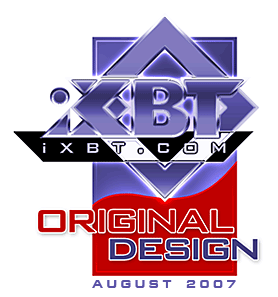
Dmitriy Laptev (lpt@ixbt.com)
August 31, 2007 Write a comment below. No registration needed!
|
Platform · Video · Multimedia · Mobile · Other || About us & Privacy policy · Twitter · Facebook Copyright © Byrds Research & Publishing, Ltd., 1997–2011. All rights reserved. | |||||||||||||||||||||||||||||||||||||||||||||||||||||||||||||||||||||||||||||||||||||||||||||||